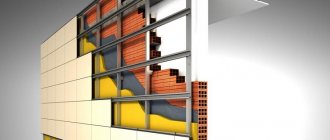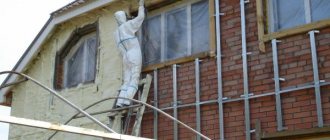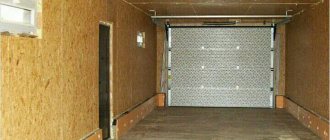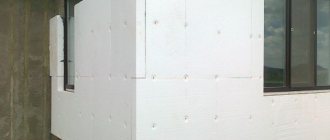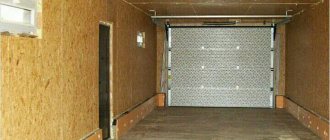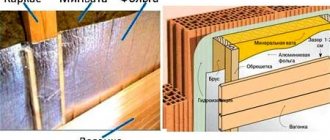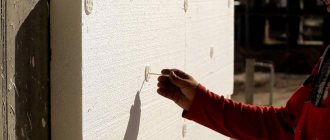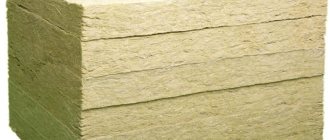There are several options for insulating a wooden house with foam. There are also several types of foam and different methods of application. You can insulate the houses you live in and those just under construction. It is used for internal and external insulation.
Foam is a fairly good material for insulation; it adheres very firmly to wood. Does not leave any gaps for further penetration of cold or moisture. It also provides good sound insulation.
Features and characteristics of the material
A special feature of the material is the presence of special gaseous substances in it that help achieve minimal thermal conductivity. Due to the porous structure, it is possible to create a layer of air, as well as reliably fix the material in the right place. After application to the surface in a liquid composition, a chemical foaming reaction begins. The foam gradually reaches its maximum size, polymerizes and hardens.
Mixtures offered on the market often contain toxic substances, so when insulating with polyurethane foam, it is important to follow safety precautions and use personal protective equipment. This is the only way to avoid damage to the skin, respiratory system and eyes. At the same time, the hardened material is safe.
Penoizol
This is a cheaper foam insulator. Its properties are worse than those of polyurethane foam; it is made from urea polymer. When foaming, the volume increases 20-30 times, forming an open-porous foam structure. It has the highest vapor permeability among foam heat insulators. Cured foam resembles polystyrene foam. Due to its low density, it cannot withstand severe mechanical loads. To insulate small surfaces, already hardened sheets are most often used. In large-scale construction, to obtain foam, the ingredients are mixed in special machines and applied by spraying. Final hardening time is 3 days.
Penoizol is used for external insulation of brick walls, roofs, roofing systems from the inside, walls and partitions of frame structures. Satisfactory adhesion to rough surfaces. No adhesion to smooth surfaces of glass, plastic, metal.
The material is non-flammable, does not support combustion, under the influence of high temperature it becomes charred and decreases in size.
Does not change performance properties at temperatures from -100°C to +120°C. The service life reaches up to 78 years. Excellent resistance to microorganisms and weak acidic and alkaline environments.
Is it possible to insulate walls with foam?
Polyurethane foam is often used during construction work. This material is chosen for prompt and effective insulation of house walls. It is important to minimize the number of seams and carefully handle cold areas. Complete and careful sealing of the surface will become the basis for creating a comfortable indoor climate.
Insulation of walls from the outside
Insulating external walls with foam is a common task during the construction or renovation of a private home. In this case, it is important to observe the dew point, taking into account which will ensure dry and warm walls for many years. A careful approach to external insulation of the walls of a house with foam will allow you to achieve a high level of energy savings, preserve the footage of the room, get rid of condensation, and also improve sound insulation performance.
The disadvantages of such a solution include impressive implementation costs, including the work of craftsmen and the rental or purchase of special equipment. But even similar costs for insulating facades with foam will quickly pay off due to savings on heating.
Indoors
The walls of the room are insulated from the inside with foam only if it is not possible to carry out the plan from the outside. This applies to work with apartments in multi-storey buildings.
The insulation process shifts the dew point, so special attention must be paid to waterproofing. Neglecting this recommendation can lead to moisture condensation on the walls, fungus, or even destruction.
Types of foam insulation for walls
In most cases, three types of foam are used for wall insulation:
- mixture in cylinders;
- penoizol;
- sprayed polyurethane foam.
Let's take a closer look at each type.
Polyurethane foam in cylinders
Foam insulation in cylinders seems to be the most affordable and easy to use method. This solution works great when working with small areas. We are talking about minor repairs or redevelopment here. When processing a large number of surfaces, savings quickly turn into even greater costs.
Foam in cylinders can be used as an additional reinforcement element when installing the main insulating material in the form of blocks. It is convenient to fill joints and seams, ensuring maximum tightness of the resulting structure.
The market offers many varieties of foam in cylinders, among which it is not difficult to find a mixture with increased adhesion for use as an adjuvant.
Penoizol
Penoizol is a type of foamed plastic, which, after hardening, acquires the necessary strength properties. The base used here is special urea polymers, which help deliver the product in the form of a liquid mixture, ready-made slabs of any shape, or granules for pouring into voids.
Penoizol is a type of foam plastic
Penoizol is especially often used to insulate frame houses. The foaming composition is capable of filling the spaces between walls, sheet panels and floor layers. Thus, comprehensive insulation with polyurethane foam is ensured with minimal labor costs.
Advantages of penoizol:
- quickly applied to surfaces;
- does not change its properties under the influence of temperatures or moisture;
- able to last for many years;
- low flammability;
- not suitable for mold formation;
- not interesting to rodents;
- resistance to external mechanical deformations.
Penoizol is also able to absorb excess noise and smooth out vibrations.
Spray polyurethane foam
This type of polyurethane foam is extremely popular in civil engineering. It is easy to apply and dries quickly, forming strong, closed cells. Usually a layer of no more than 10 cm is applied, since the properties of the material are sufficient for thermal insulation of even the largest rooms. At the same time, excellent adhesion with other structural elements is observed. Polyurethane foam for wall insulation is combined with wood, stone, metal, plastic or brick. Closed cells prevent moisture from penetrating inside, also providing waterproofing. Can be used indoors or outdoors.
Spray polyurethane foam after hardening
The material effectively insulates the interior of the room from various influences, preventing temperature, moisture or vapor from penetrating through the walls. High fluidity helps to penetrate even the most difficult to reach places, ensuring complete elimination of gaps. Also positive aspects include biological stability, which means repelling rodents and preventing mold from occurring. Foam insulation in the air gap between the walls is especially effective.
Application requires special equipment, the price of which must also be taken into account.
Insulation process
You can do foam insulation with your own hands in cases where the use of special equipment is not required. For example, cracks have formed in door or window openings. It is enough to blow them out with foam from a can. Or use it to insulate a small area. In cases where it is necessary to insulate entire walls, it is more rational to resort to hiring specialists who will quickly, efficiently and correctly do all the work. In this case, there is no doubt that the insulation of walls with foam will last for decades.
The whole process can be divided into preparatory work and application of the product. What does the preparation include? To begin with, it is important to remove everything that will interfere with high-quality adhesion: old finishing material, greasy stains, dust and dirt.
Then, vertical guides are fixed at a distance of 50 cm from each other (and from the wall). These are blocks of wood. An empty space is formed between them, into which foam insulation for the walls is filled. In addition, after work, it will be possible to attach finishing to them, for example, drywall, lining or similar sheet materials.
As for laying communications, namely, electrical wires and pipes, everything is done before the spraying process. Wires should ideally be protected with corrugation (plastic or metal sleeves).
After all the preparatory work, you can perform foam insulation. The process is reminiscent of painting with a spray gun. Under the influence of a compressor, the mixed components are fed into the sprayer and then transferred to the surface. The first step is to process the seams, joints, cracks and cavities. This will eliminate voids. After that, all that remains is to process the space between the created sheathing. The movements are smooth and sweeping. If the surface is vertical, then it is covered from bottom to top.
This is where the insulation of the house ends. All that remains is to complete the finishing with the selected material.
Which foam manufacturer is better to choose?
It is best to pay attention to the products of well-known companies that have managed to win the recognition of users with their many years of work.
The most popular companies can be considered:
- A well-known brand with several factories in Europe. All products meet high standards and are tested immediately before being released for sale. Even with prolonged use, this material does not darken, retains its dimensions, and also copes with its main task.
- In all possible ratings of manufacturers, this company consistently holds bronze. This brand's mixture foams without third-party intervention, which significantly improves ease of use.
- The company has long been producing high-quality mixtures with high performance indicators. Users also note the cost-effectiveness of this solution when processing large areas.
- A universal product with a uniform structure and a sufficient level of density. Fills all seams and cavities, providing high-quality protection from the cold.
- The moment of installation. An affordable solution with good characteristics from a domestic supplier.
- A popular product with high fire resistance. Suitable for insulating windows and doors. And its relatively low cost makes it one of the most attractive options.
Advantages and disadvantages of foam insulation
Insulation materials, like other building materials, have their own list of advantages and disadvantages. It is important to consider these features before the procedure, so as not to encounter unpleasant surprises later.
Pros:
- the special structure helps to penetrate into the most inaccessible places;
- after hardening, a monolithic coating without seams is formed, helping to minimize heat losses;
- thermal insulation with polyurethane foam has virtually no effect on the walls;
- after hardening, the material is harmless to humans and nature;
- insulating ceilings or walls with foam does not require almost any preliminary preparation of surfaces;
- high-quality sound insulation due to the porous structure;
- no need to create additional frames to hold the material on the walls;
- Application to metal surfaces helps protect them from corrosion.
The main disadvantage of the material is its high cost. Insulating a wooden house with foam is more expensive than using other methods.
How to apply, order of work
Violation of the foam application technology will result in minimal effect from the use of sealant. To avoid problems and difficulties, you must strictly follow the instructions . Recommendations for the use of their own products are provided not only by large manufacturers (such as Makroflex, Soudal, Tytan, TECHNONICOL), but also by small enterprises. Since, despite the generality of some tips, each option has specific parameters that determine the scope of application and the order of work. The process of applying foam to the base (working surface) is as follows:
Foam Soudal Construction and Repair 500 ml. Photo Petrovich
The performer must prepare for the work by wearing gloves, goggles and a respirator (or using a mask), it is better to wear long sleeves. The surface also needs to be prepared, i.e. clean from dust, debris, old coating using a soft brush, brush, or rag. If there is frost, ice, or snow on the surface, it is necessary to remove them mechanically. If the surface is too dry, moisten it with water.
Most often, foam is used to seal cracks and gaps. It is suitable for filling cavities from 2 to 8-10 cm . Gaps of larger width must be reduced by sealing with pieces of foam plastic or its analogues . Cavities larger than 4 cm wide and 5 cm deep are filled in several layers . The next layer is applied after the previous one has hardened. Gaps up to 1 cm are filled with sealants or putty; they do not have secondary expansion.
The container is shaken for 30-60 seconds ; different manufacturers have different recommendations.
The cap is removed from the cylinder, the tube is fixed or the gun is screwed on. Some difficulties are caused by installing the gun, which is performed as follows. The protective cover is removed from the upper container of the “weapon” , it is turned with the handle down, and the cylinder is screwed into it. The container is screwed in with force until a hissing sound appears, which means that the mixture has begun to flow into the nozzle.
Mounting foam MACROFLEX WhiteTeq professional 750 ml. Photo by Maxidom
The edge of the tube or gun is brought to the area to be foamed and the valve or trigger is pulled.
The seams are filled in a zigzag motion, vertical voids are filled from bottom to top.
A few minutes later, after the formation of a surface film, the treated surface is checked for defects ; if small “gaps” remain, they need to be filled.
After eight to twelve hours it is possible to remove excess polyurethane foam . Manufacturers indicate the time of primary processing, because this indicator is one of the main ones. The best option is to wait 24 hours, then perform pruning manipulations.
An obligatory step is finishing work, since the seams are “afraid” of ultraviolet radiation, so plastering, painting or other cladding is required.
On the ceiling, how to foam so that the foam does not fall
The technology for applying foam to the ceiling for sealing seams between concrete slabs, gaps between chipboard sheets and solving other problems is no different from the standard one . But there are several nuances .
In the process of foaming gaps on the ceiling, a problem often arises - the foam falls from the ceiling and does not stick to the surface . To avoid this, it is necessary to carefully prepare the base , remove dust thoroughly, and it is recommended to use a vacuum cleaner. The surface is moistened with water from a spray bottle. But it is important that there are no drops of moisture. If necessary, the base can be degreased.
To achieve foam output with constant pressure, the container must be held upside down . This does not always work out, so the length of the tube or gun must be increased by connecting a flexible adapter to the nozzle ; some manufacturers sell it complete with foam. Or opt for foam that can be filled in any position of the cylinder, for example Tytan Lexy. An alternative is PVC tubing (drip tubing) that also connects to the nozzle. Performers also offer other devices.
If the measures taken are not enough, then there is an alternative drastic solution . To do this you will need masking tape to seal the seam. Holes are formed in the tape through which foaming is carried out. After the polyurethane foam has hardened, the tape must be removed. In addition, the gap can be reinforced with metal mesh or wooden slats.
How to foam a window in an apartment, a wooden house and more, from the street
Sealing double-glazed windows using polyurethane compounds is perhaps the most important stage in the installation of structures as a whole. Attentive attention to this process allows you to eliminate the occurrence of problems. Let's look at the work process:
Gun foam Mastertex B1 fireproof 750 ml. Photo by Leroy Merlin
1) Determining the type of opening . The initial stage of work is to determine the type of opening. In most cases, there are quadruple and non-quadruple openings. It is easy to seal seams in structures of the first type; the work does not require any special skills. The quadruple opening is filled with sealant on both sides, otherwise the seam will lose its integrity.
2) Determination of the gap width. Experienced performers prefer to work with gaps no more than 5 cm wide. Larger cavities are filled in several passes, after the previous one has dried.
3) Material of the opening. In most cases there is not much difference between the base materials. Polyurethane foam has adhesion to many building materials: concrete, wood, brick, metal. Increased attention should be paid only to the aerated concrete base; the opening should be treated with a primer. Other surfaces only require wetting with water.
4) Determination of the type of foam. When installing windows, both household and professional foam can be used. Depending on the ambient temperature, summer or winter foam is used. Universal all-season foam is not recommended for use; the best option is to use specialized foam. Depending on the availability of fire safety requirements, it is possible to use non-flammable compounds marked “B1”, self-extinguishing (“B2”) or flammable (“B3”). In accordance with the number of components, one- and two-component compositions are distinguished. Products of the second type have more advantages, but their use requires the appropriate skills.
5) The preparatory stage includes the standard manipulations presented earlier.
6) Isolation. Foam needs additional protection - internal vapor barrier and external waterproofing (! but some performers use foam for waterproofing). For this, vapor barrier tape and compressed sealing tape (PSUL) or vapor-permeable waterproofing tape are used. The vapor barrier tape is fixed with a narrow adhesive layer along the entire length of the box. The second edge remains free. PSUL is glued to the front side of the window frame without overlap or tension, along the side and top sides. The covered window fits neatly into the opening. The waterproofing tape is glued under low tide and cut off with a margin.
Professional mounting foam TYTAN 65 750ml. Stroylandia Photos
7) Foaming is carried out in accordance with general recommendations. The free edge of the vapor barrier tape is moved back, then it is glued to the moistened assembly seam.
How to repair a hole in a car sill
Car owners are faced with the problem of through holes appearing in their sills . The optimal and necessary solution in this case is cleaning and welding problem areas . As an alternative but temporary measure it is possible to consider the use of polyurethane foam. The work is performed as follows.
Pistol foam Maxi Arctic, professional, 870 ml. Photo by Leroy Merlin
place cardboard under the rotten threshold and fill the gap with foam. To compact the polyurethane mass, you need to cover it on the front side with cardboard to allow it to harden. After hardening the excess is removed with a knife , and the foam is given the required shape. The area to be repaired is separated from the rest of the car with masking tape. The area is sanded, degreased, treated with epoxy putty, then sanded and putty again, but using a finishing putty. The surface is sanded until perfectly smooth with zero-grit sandpaper. The molding and wheel near the area to be repaired are covered with masking tape and thick fabric or film.
The restored area of the body is degreased and covered with primer from an aerosol can . When the soil dries, any roughness that appears is sanded with a “zero” polish. The final stage is the application of paint; if necessary, a layer of varnish is applied.
Price
Construction foam can be purchased in large quantities or at retail. Foam in cylinders for insulation will cost about 400 rubles. But few people actually use small quantities of the material. Usually large volumes are required, the cost of which the construction company tries to include in the cost of the work. In this case, they ask for about 100 rubles per linear meter. Penoizol can cost from 600 to 2500 rubles per cubic meter. The cost of polyurethane for a similar volume is usually not less than 3,000 rubles.
Builders recommend not saving on insulation, since a low-quality mixture has a short lifespan and quickly ceases to fulfill its main function. But high-quality material can last for many years, providing comfortable indoor conditions.
Wall insulation in the form of foam seems to be the most successful solution, since you can carry out the procedure yourself. Compliance with all the rules and a responsible approach to business will allow you to insulate the surface and save on the services of the construction team.
Temperature changes outside should have minimal effect on the temperature inside the house. Additional foam walls can isolate the room from influences, performing the function of vapor barrier and waterproofing. Modern materials help achieve results in a short time without using complex methods.
